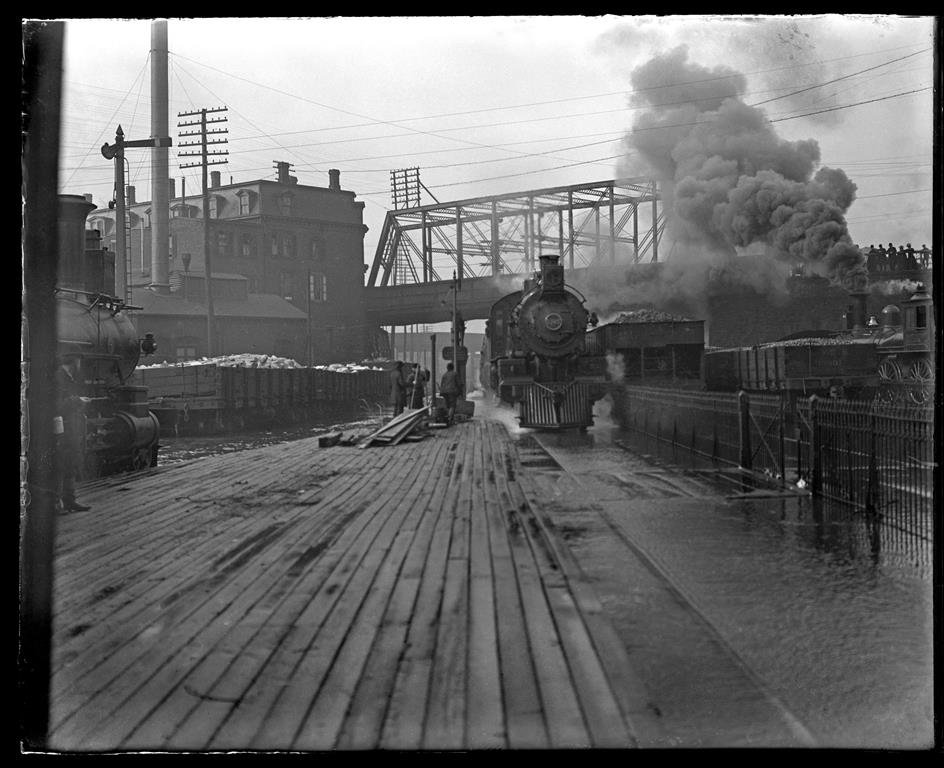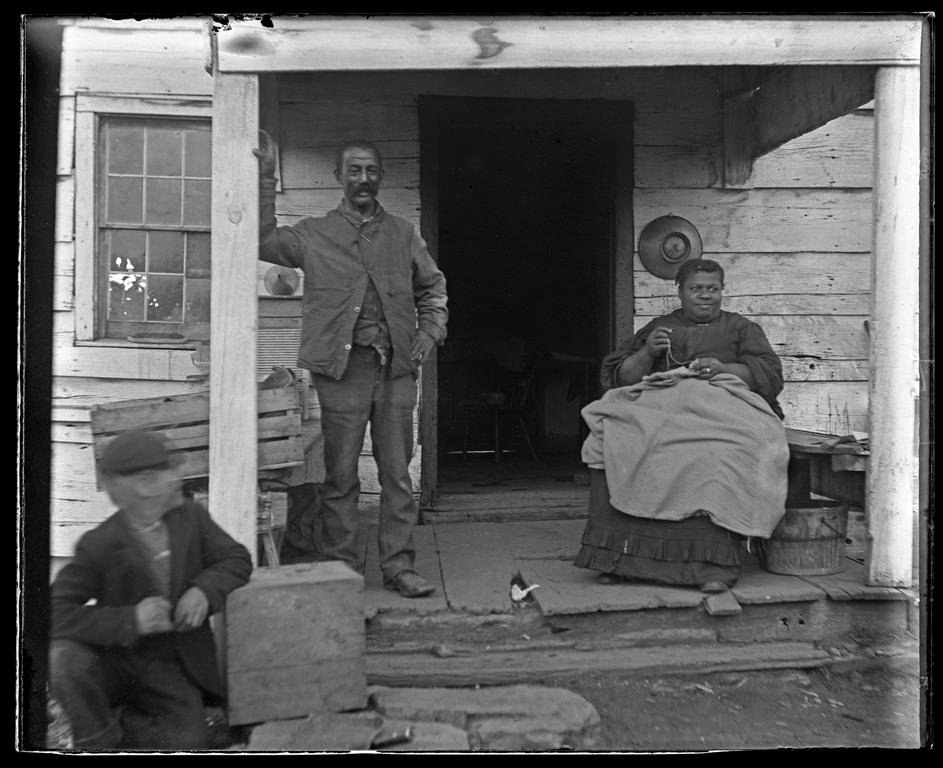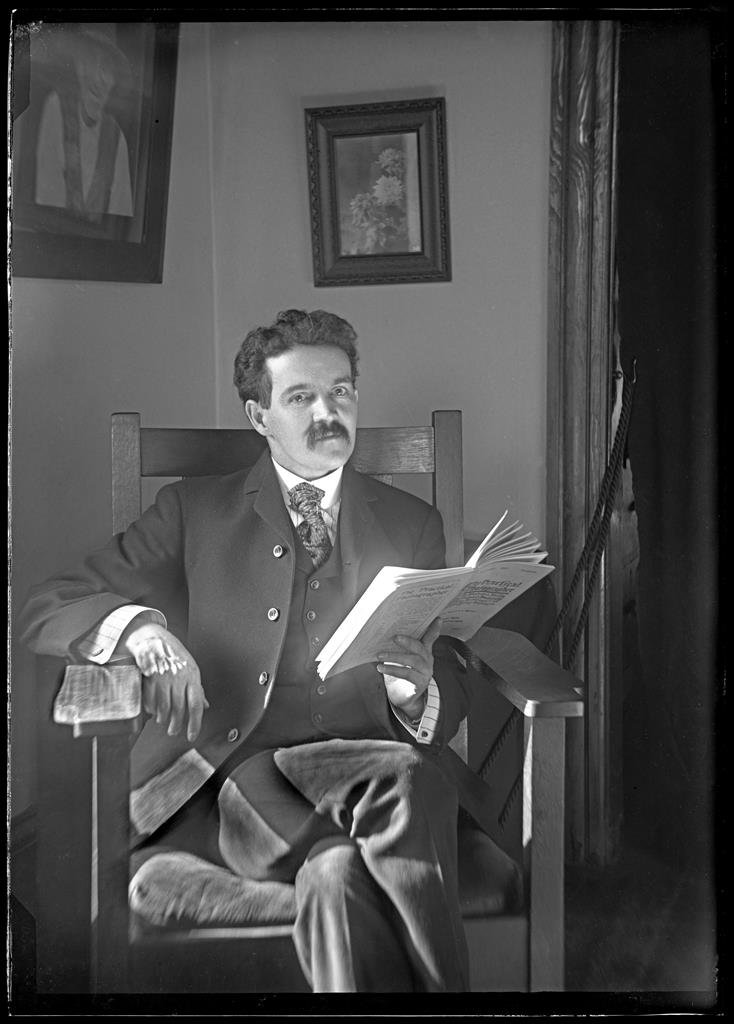History Relayed by a Fine Artist
The woman in the photograph wears a perfectly crisp blouse, skirt, and apron. Even the mending work on her lap looks freshly ironed—and mind you, this was several decades before the permanent press was a thing. The combination of polka dots, checks, and plaid on the statuesque figure projects a panoply of patterns with the screen door behind her.
The potted plants lined up on the shelf alongside the African American septuagenarian are equally well cared for, along with the espaliered tree and the hanging basket. The woman is Dinah Hartman from Milford, New Jersey. Photographed in 1898, she worked as a nanny and domestic worker but you wouldn’t know this from photographer Grant Castner’s notation. It took the exploratory work of New Jersey State Museum Curator of Cultural History Nicholas Ciotola to suss out the details of Dinah’s and other subjects’ lives. Such details predated any internet trace.
Locomotive entering depot, Clinton Street Station, Trenton, New Jersey, 1902. Digital print from 4” x 5” glass plate negative. Courtesy of New Jersey State Museum.
Discovering Grant Castner: The Lost Archive of a New Jersey Photographer remains on view at the State Museum through September 15. The exhibition includes 200 freshly printed images from a recent gift of 1,200 glass plate negatives from Castner’s 1880-1920 body of work.
The gift is a perfect fit for the museum, whose focus is the exploration of science, history and the arts. The collection helps to tell the history of the Capital region through an artist’s eye.
As curator of Cultural History, Ciotola has put together exhibitions on the regional history of immigration, ceramics, toy making, the state’s role in the Civil War, and the impact of 9/11, using the rich collections from the museum’s archives.
In his role at a collecting institution with more than 2.5 million objects, Ciotola fields hundreds of calls from potential donors, only a small fraction of whom can offer something of need. But when he got the call from Robert Jones in 2019 about the glass plate negatives, he assembled an emergency meeting of the collections committee and made his pitch for the approval process.
Jones, a New Jersey native residing in Arizona, was attending to the estate of his son-on-law William Paquin, an antiques dealer working in Lambertville who had acquired the Castner collection from an unknown source (Paquin died in 2017).
Ciotola met Jones at the storage locker in Hunterdon County where the negatives were still packed in their original box, wrapped in newspapers dating from the 1940s – Castner died in 1941. Although there is a gap in knowledge of the whereabouts of the collection from Castner’s death until acquisition by Paquin, Ciotola was able to track down Castner’s grandson in Maryland.
“I had to do reverse genealogy and then look for him on social media,” says Ciotola.
Ciotola traveled to Maryland to learn more about Castner and his family. John Castner was born after his grandfather died but knew about him from family stories. He had his own collection of prints made by his grandfather but hadn’t any idea of the existence of the glass plate negatives. Ciotola speculates that at some point, someone cleaning out an attic or basement may not have realized the value of the negatives.
What makes the collection special, says Ciotola, is that it reflects the everyday life of New Jerseyans from the 1880s to the 1920s. It tells the stories of the railroads, canals, schools, landmarks, and people at work and at leisure.
“The Dillons” Thomas and Susan Dillon, near Jacobs Creek, Ewing Township, New Jersey, 1899. Digital print from 4” x 5” glass plate negative. Courtesy of New Jersey State Museum.
Castner was a people person, according to exhibition didactics, and rather than have a photographic studio where people would come and sit for portraits, Castner went out into the field, photographing them in their own environments. It is apparent that his subjects were relaxed in his presence, even enjoyed his attention.
“We don’t always preserve the history of everyday people,” says Ciotola. “Thanks to Grant Castner, we know that people like Dinah existed.”
Although Castner was a white man, he photographed the African American community in equal measure. During the time before schools were integrated, he documented racially segregated schools, including the Columbia School. A newer more modern school was built nearby where white children were transported by wagon while Black children had to walk to the old school. At appears Castner spent significant time with the children, getting to know them. He also photographed students tending a garden during the original school garden movement that advocated for a gardening curriculum: the science of plants and the importance of the natural world and food production.
Upon receipt of the gift, the museum catalogued the collection and scanned high resolution digital negatives. From those, Ciotola and photographer/historian/archivist Gary Saretzky, serving as curatorial consultant, whittled it to those that would be printed by Taylor Photo in Cranbury. Photoshop was employed to brighten and lighten some areas, but the glass plates were in remarkably good condition, says Ciotola. (They are now safe in modern archival storage.) The decision was made to print the edges of the glass plates so viewers can see the flaking edges of the emulsion, the cracks, that are part of the history.
Even after celluloid film became available, Castner continued using glass plate technology because of the detail it offers. He made both contact prints and enlargements. Here, the museum has made enlargements matted as fine art, retaining the level of detail .
Grant Castner self-portrait, Trenton, New Jersey, 1906. Digital print from 5” x 7” glass plate negative. Courtesy of New Jersey State Museum.
At the entrance to the exhibition is a blow up of one of Castner’s self-portraits. Although primitive technology for “selfies” existed at the time, Ciotola speculates that Castner set up the scene and had a friend or relative press the shutter button.
Pictured with his large-format wooden camera on a tripod under one of the two historic stone arch bridges over the Stony Brook in Princeton, Castner is a dapper looking gentleman. Having grown up in Belvidere, where his father ran a bookshop and Castner developed a lifelong love of reading, he came to Trenton as a young man seeking work. Castner made his living as a newspaper distributor for the Union News Company which had a contract to supply kiosks for the Pennsylvania Railroad. He lived on Tyler Street, near the Trenton Train Station which had a Union News kiosk. The brick row house still exists, though it has been re-sided.
Castner, who as a 15-year-old published his own newspaper and sold subscriptions, was a newspaperman at heart. And it was his work in and passion for the news industry that led to his photojournalistic approach. Castner is considered an amateur because photography was not his financial bread and butter, but he did some commercial work in addition to the photographs he made out of his own interest.
He had to have made a good living to have afforded his camera, tripod, the glass plate negatives, even a car (though in the early years Castner got around by bicycle, as seen in one of his self-portraits), says Ciotola. And he had the leisure time to pursue photography.
In one vitrine are the glass plate negatives and the wooden boxes they were stored in. At three-by-five inches, they were portable enough to take on his bicycle.
These were dry plates, an improvement over the wet plate technique that required developing immediately in a studio. The dry plate could be put in a light-proof box and developed days later.
The supplies were readily available in Trenton at the time, where an interest in photography was in vogue.
Castner was one of the founders of the Trenton Photographic Society, also known as the Trenton Camera Club. The group shared materials, group discounts on purchasing, darkroom equipment, and magic lantern shows of their work. Magic lantern shows involved projecting glass slides onto the wall. They partnered with the School of Industrial Arts (now Mercer County Community College) for exhibitions.
Tornado aftermath, Perry Street, Trenton, New Jersey, 1902. Digital print from 4” x 5” glass plate negative. Courtesy of New Jersey State Museum.
Ciotola has supplemented the 200 photographs with artifacts from the museum’s collection that help to tell the stories: men’s and women’s hats of the era, a school desk, pottery, even bisque dolls from Trenton’s Fulper Pottery Company to supplement Castner’s image of his daughter, Eleanor, clutching a doll that resembles those made by Fulper. It is interesting to learn that in order to use “flash” in low light, a photographer had to light a flammable sheet and let it burst into flame.
Castner’s photograph of a man depicted through the bore of a monstrous, 14-foot cannon aboard the U.S.S. Raleigh almost looks avant-garde and earned him a writeup in the Trenton Evening Times.
One of Castner’s favorite spots in Trenton was the Battle Monument where, atop its tower, he could get a bird’s eye view of the city. His love for Trenton is apparent in his photographs, and he is buried in the city’s Greenwood Cemetery. “Although ‘Trenton Makes, the World Takes’ is emblazoned on the bridge, and everyone knows of Trenton as a major manufacturer of wire rope and ceramics, studying Grant Caster’s life and times, I was amazed to discover the massive amateur photographic community that made the fledgling art form thrive,” says Ciotola.
Trenton, NJ | Open through September 15th, 2024
LINKS
New Jersey State Museum
Discovering Grant Castner
Subscribe to Our Newsletter







